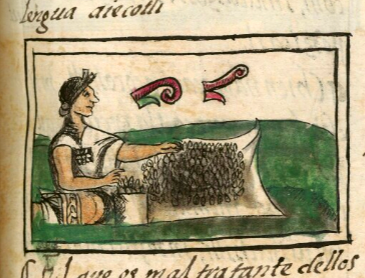enamacac (tlahueliloc) (FCbk10f48r)
This iconographic example, featuring a “bad” woman bean seller (tlahueliloc enamacac), is included in this digital collection for the purpose of making comparisons with related hieroglyphs. The term selected for this example comes from the text on the page prior to the image in the Digital Florentine Codex. There is no gloss, per se. This example shows a woman kneeling (seemingly with bare knees) on green grass next to a large white cloth (probably a cuachtli) that is covered with beans (etl), which she is selling (namaca). There is also a tall, white, round container full of beans near her knees. This may be a measure for selling a certain quantity of beans. The beans appear to be black beans. The woman is shown in a ¾ view, facing right. She wears a white cotton huipilli with what may be an eight-petalled flower or sun symbol on the chest patch at the bottom of the V-neck. All the fabric in this image shows shading, giving it a three-dimensionality, which reveals European artistic influences. The woman’s hair is in the traditional style (neaxtlacualli or axtlacuilli) for adult or married women, with the hair twisted up into two points above her forehead. In the air in front of the woman’s face are two glyph-like signs. One is apparently a red speech scroll with something like a green leaf added below it. This may well indicate that her speech is untrustworthy, that she might be lying or cheating the customer. To the right of that is what might appear to be a speech scroll, but it has the shape of some glyphs for air or wind (ecatl or ehecatl). Perhaps this is a phonetic indicator that the term for beans (etl) starts with e-. If not, then both of these signs may refer to the deceitful activities and speech of the “bad bean seller.” This codex typically provides vocabulary that critiques the “bad’ and praises the “good” behavior for each type of person or occupation.
Stephanie Wood
See below for some glyphs to compare with the sign (possibly ecatl or ehecatl) in the air on the right of the woman’s face. Nahuatl hieroglyphs for beans tend to focus on a single bean or a small number of beans, usually black, and usually with a white spot. Bean glyphs can also have a phonetic role, indicating the -e- sound.
Stephanie Wood
tlaueliloc enamacac
tlahueliloc enamacac
Stephanie Wood
1577
Jeff Haskett-Wood
frijol, beans, comida, tlanezcayotiliztli, volutas, volutes, scrolls, comercio, mercado, mercados, tianguis, mujeres, vendedoras, vendedora
enamacac, bean seller, https://nahuatl.wired-humanities.org/content/enamacac
tlahueliloc, perverse, bad, malicious, https://nahuatl.wired-humanities.org/content/tlahueliloc
e(tl), bean(s), https://nahuatl.wired-humanities.org/content/etl
-namacaqui (pl. -namacaque), a suffix referring to an occupation, often a merchant selling something; in the Florentine Codex, often written in the singular as -namacac, https://nahuatl.wired-humanities.org/content/namacaqui
la mala vendedora de frijoles
Stephanie Wood
Available at Digital Florentine Codex/Códice Florentino Digital, edited by Kim N. Richter and Alicia Maria Houtrouw, "Book 10: The People", fol. 48r, Getty Research Institute, 2023. https://florentinecodex.getty.edu/en/book/10/folio/48r/images/0 Accessed 10 September 2025.
Images of the digitized Florentine Codex are made available under the following Creative Commons license: CC BY-NC-ND (Attribution-NonCommercial-NoDerivs 4.0 International). For print-publication quality photos, please contact the Biblioteca Medicea Laurenziana ([email protected]). The Library of Congress has also published this manuscript, using the images of the World Digital Library copy. “The Library of Congress is unaware of any copyright or other restrictions in the World Digital Library Collection. Absent any such restrictions, these materials are free to use and reuse.”









